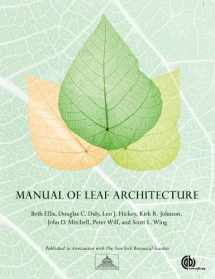
Manual of Leaf Architecture
ISBN-13:
9781845935856
ISBN-10:
1845935853
Edition:
First Edition
Author:
Kirk R. Johnson, Beth Ellis, Douglas C. Daly, Leo J. Hickey, John D. Mitchell, Peter Wilf, Scott Wing
Publication date:
2009
Publisher:
CABI
Format:
Paperback
220 pages
FREE US shipping
Book details
ISBN-13:
9781845935856
ISBN-10:
1845935853
Edition:
First Edition
Author:
Kirk R. Johnson, Beth Ellis, Douglas C. Daly, Leo J. Hickey, John D. Mitchell, Peter Wilf, Scott Wing
Publication date:
2009
Publisher:
CABI
Format:
Paperback
220 pages
Summary
Manual of Leaf Architecture (ISBN-13: 9781845935856 and ISBN-10: 1845935853), written by authors
Kirk R. Johnson, Beth Ellis, Douglas C. Daly, Leo J. Hickey, John D. Mitchell, Peter Wilf, Scott Wing, was published by CABI in 2009.
With an overall rating of 4.0 stars, it's a notable title among other
books. You can easily purchase or rent Manual of Leaf Architecture (Paperback) from BooksRun,
along with many other new and used
books
and textbooks.
And, if you're looking to sell your copy, our current buyback offer is $0.93.
Description
This is an essential reference for describing, measuring and classifying the foliage of flowering plants. The presented system provides long-needed guidelines for characterizing the organization, shape, venation, and surface features of angiosperm leaves. In contrast to systems focusing on reproductive characters for identification, the emphasis is on macroscopic features of the leaf blade including leaf characters, venation, and tooth characters. The advantage of this system is that it allows for the classification of plants independently of their flowers, which is especially useful for fossil leaves (usually found in isolation) and tropical plants (whose flowering cycles are brief and irregular, and whose fruits and flowers may be difficult to access). An illustrated terminology including detailed definitions and annotated illustrations is the focus of the classification system, the aim of which is to provide a framework with comparative examples to allow both modern and fossil leaves to be described and classified consistently.


We would LOVE it if you could help us and other readers by reviewing the book
Book review

Congratulations! We have received your book review.
{user}
{createdAt}
by {truncated_author}


